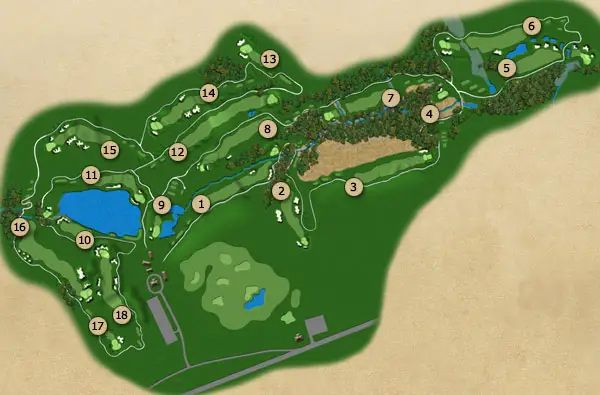How Many Holes In A Golf Course

Golf, with its rolling fairways, meticulously designed greens, and challenging hazards, has captivated players for centuries. As golfers traverse the course, one question often comes to mind: How many holes are there in a golf course?
The number of holes in a golf course is a fundamental aspect that shapes the game and the overall experience for players. The traditional answer is 18 holes, but golf courses come in various configurations and sizes, offering alternatives to suit different needs and preferences.
In this article, we delve into the fascinating world of golf course hole counts. We explore the standard 18-hole design, the reasons behind its prominence, and the historical significance of this configuration. We also venture into the realm of alternative hole counts, including 9-hole courses and executive layouts, which provide shorter and more time-friendly options for golfers.
Understanding the factors influencing hole counts in golf courses allows us to appreciate the diversity within the sport. We examine regional variations, notable exceptions, and the impact of space availability and player demands on course design.
So, whether you’re an avid golfer seeking to expand your knowledge or a curious newcomer to the game, join us as we unravel the mysteries surrounding the number of holes in a golf course and gain a deeper appreciation for the intricacies of this beloved sport.

Exploring the Standard Golf Course Design
A golf course typically consists of a specific number of holes, each offering unique challenges and opportunities for players. The standard and most prevalent design is the 18-hole golf course. This format has become the benchmark for golf courses around the world.
The Concept of the “Front Nine” and the “Back Nine”
The standard 18-hole design is further divided into two halves: the front nine and the back nine. Each half consists of nine holes, creating a balanced layout for golfers. The front nine is usually played first, followed by the back nine. This division allows for strategic pacing and ensures that players encounter a variety of hole types and terrain throughout their round.
The Historical Significance of 18-Hole Golf Courses
The origin of the 18-hole format can be traced back to Scotland, the birthplace of golf. The Old Course at St Andrews, dating back to the 15th century, is often cited as one of the earliest examples of an 18-hole golf course. Over time, the 18-hole design gained popularity and became the standard for golf courses worldwide.
The 18-hole format offers a balance between challenge and playability. It allows golfers to experience a comprehensive range of hole lengths, obstacles, and strategic considerations. Golf tournaments, including major championships such as The Masters, the U.S. Open, and The Open Championship, are typically played on 18-hole courses.
Variations in Golf Course Sizes and Hole Counts
While the 18-hole design is the most common, there are variations in golf course sizes and hole counts that cater to different preferences and constraints. These alternatives provide golfers with diverse options and opportunities to enjoy the game.
9-Hole Golf Courses: A Popular Alternative
For golfers seeking a shorter round or those with limited time, 9-hole golf courses offer a viable solution. These courses feature only nine holes, allowing players to complete a round in less time while still experiencing the joys and challenges of the game.
9-hole courses are often preferred by beginners, juniors, or recreational golfers looking for a quick golfing fix. They can be found in various settings, including public courses, private clubs, and resort facilities. Additionally, some golf courses with 18 holes may offer the flexibility to play just nine holes, providing options for players with time constraints.
Executive Courses: Compact Layouts with Shorter Holes
Executive golf courses, also known as par-3 courses, offer yet another alternative to traditional 18-hole designs. These courses feature shorter holes, typically par 3, and are designed to be more compact in size. Executive courses provide an excellent opportunity for beginners to learn and practice their skills, as well as for experienced golfers to refine their short game.
The advantage of executive courses lies in their accessibility and suitability for players of all skill levels. They often offer a relaxed and casual atmosphere, making them popular among families, seniors, and golfers who enjoy a quick round.
Factors Influencing the Choice of Golf Course Size and Hole Count
The decision to design a golf course with a specific hole count depends on various factors, including space availability and land constraints, player preferences, and considerations for golf course maintenance and sustainability.
Space Availability and Land Constraints
The available land area greatly influences the choice of golf course size and hole count. In urban areas or regions with limited land resources, it may be challenging to accommodate a full-scale 18-hole course. In such cases, golf course architects and developers must adapt the design to fit the available space. This may result in the creation of smaller courses with fewer holes, such as 9-hole or executive courses.
On the other hand, expansive rural areas or regions with abundant land resources provide the opportunity for larger, full-length courses. These areas allow for the traditional 18-hole layout and the incorporation of diverse terrain features, such as rolling hills, water hazards, and dense forests, which add to the course’s appeal and challenge.
Golf Course Accessibility and Time Considerations
The accessibility of a golf course and the time required to complete a round are significant considerations for golfers. Some players may have limited availability and prefer shorter rounds, while others may seek a more comprehensive golfing experience. Golf course owners and operators take these factors into account when deciding on the size and hole count of their courses.
Having 9-hole or executive courses can make golf more accessible to individuals with time constraints or those who prefer a shorter playing experience. These courses offer a convenient option for a quick round during lunch breaks, after work, or for those seeking a leisurely golf outing without committing to a full 18-hole round.
Moreover, offering different course sizes and hole counts allows golf facilities to cater to a broader range of players. It accommodates beginners who may find a full 18-hole round overwhelming, families looking for a recreational activity, or golfers who want to focus on specific aspects of their game, such as short game skills on executive courses.
By providing various course sizes and hole counts, golf courses can meet the diverse needs and preferences of golfers, ultimately enhancing the overall golfing experience.
Golf Course Configurations Around the World
While the standard 18-hole design is widely prevalent, there are notable regional differences and preferences when it comes to golf course configurations. Let’s explore some of these regional variations and their impact on hole counts.
United States: Focus on 18-Hole Courses
In the United States, the 18-hole golf course is the predominant configuration. The country is home to numerous world-renowned golf courses, including iconic layouts such as Augusta National Golf Club, Pebble Beach Golf Links, and Pinehurst No. 2. These courses feature the standard 18-hole design and have hosted prestigious tournaments and major championships.
The popularity of 18-hole courses in the United States can be attributed to factors such as ample land availability, a strong golfing culture, and the historical influence of Scottish golf traditions. The expansive landscapes across the country provide the space necessary for full-length courses, allowing for the incorporation of diverse hole designs and captivating scenery.
United Kingdom: Emphasis on 9-Hole Courses and Links Golf
In the United Kingdom, particularly in Scotland and Ireland, there is a rich tradition of links golf, which often features 9-hole courses. Links courses are known for their coastal settings, undulating terrain, and challenging playing conditions. These courses offer a unique golfing experience deeply rooted in the history of the game.
The emphasis on 9-hole courses in the United Kingdom can be attributed to factors such as limited land availability in coastal regions and the historical development of the sport. Many traditional links courses were originally designed with 9 holes and later expanded to 18 as the popularity of the sport grew.
The compact nature of 9-hole courses aligns well with the fast-paced nature of links golf and offers golfers the opportunity to experience the unique challenges and natural beauty associated with these coastal courses. Additionally, 9-hole layouts make golf more accessible to local communities and allow for shorter playing times, which can be advantageous in regions with inclement weather conditions.
Notable Exceptions: Unique Golf Course Designs
While the standard 18-hole and alternative configurations dominate the golf course landscape, there are notable exceptions where golf courses feature non-standard hole counts. These exceptions often arise due to specific tournament requirements or distinctive course designs.
27-Hole and 36-Hole Golf Courses
Some golf courses feature 27 or 36 holes, deviating from the traditional 18-hole format. These courses offer increased flexibility, allowing for a variety of playing options. Golfers can choose to play either 18 holes or extend their round to experience the entire course.
Courses with 27 or 36 holes are particularly common in resort destinations, where golfers may spend several days playing different combinations of holes to enjoy a diverse golfing experience. These larger courses often provide unique challenges and stunning landscapes, attracting golfers seeking extended play and variety.
Golf Courses with More than 18 Holes for Tournament Purposes
Certain golf courses have additional holes beyond the standard 18 for the sole purpose of hosting professional tournaments. These extra holes, known as tournament loops or playoff holes, are typically designed to accommodate sudden-death playoffs or extra rounds required to determine a winner.
For example, in the event of a tie at the end of a tournament, golf courses like Augusta National have designated playoff holes to determine the champion. These additional holes are not part of the regular course layout but are utilized for specific competitive situations.
Examples of Notable Golf Courses with Unique Designs
The golfing world is home to several notable golf courses with unique designs that defy conventional hole counts. Let’s explore a couple of examples:
Augusta National Golf Club: Home of The Masters with 18 Holes
Augusta National Golf Club in Augusta, Georgia, is renowned for hosting The Masters, one of the most prestigious tournaments in professional golf. Despite its significance, Augusta National adheres to the traditional 18-hole format. The course is meticulously designed, featuring challenging holes and picturesque beauty, captivating both players and spectators.
Pine Valley Golf Club: A Renowned 18-Hole Course in the United States
Pine Valley Golf Club in New Jersey, United States, is widely regarded as one of the world’s most challenging and exclusive golf courses. Known for its stunning natural setting and strategic hole designs, Pine Valley follows the standard 18-hole layout. The course’s reputation for difficulty and its ranking among the top courses globally make it a sought-after destination for passionate golfers.
These exceptional courses demonstrate that while the majority of golf courses adhere to standard hole counts, there are exceptional designs that deviate from the norm, each with its unique allure and appeal.
Factors Influencing the Future of Golf Course Designs
As the golfing landscape evolves, several factors are shaping the future of golf course designs, including hole counts. These factors consider both player preferences and sustainable development practices.
Environmental Considerations and Sustainable Design
Sustainability has become a critical consideration in golf course design and maintenance. Golf course architects and operators strive to create environmentally responsible layouts that minimize water usage, reduce chemical inputs, and protect natural habitats.
In this context, the size and hole count of golf courses play a significant role. Developing smaller, more compact courses with fewer holes can help conserve land and reduce environmental impact. Additionally, incorporating eco-friendly practices such as native plantings, efficient irrigation systems, and renewable energy sources contribute to sustainable golf course design.
Flexibility and Adaptability of Golf Course Layouts
The demand for flexible and adaptable golf course layouts is growing. Golf courses that can easily adjust their configurations to accommodate different hole counts provide versatility and the ability to cater to changing player preferences and needs.
Flexible course designs can include modular hole setups, allowing certain holes to be combined or rearranged to create different playing experiences. This adaptability provides golf course operators with the flexibility to offer varied hole counts, such as 9-hole or 12-hole options, based on demand or specific events.
Moreover, the concept of reversible golf courses has gained traction in recent years. These courses are designed to be played in two directions, effectively doubling the number of possible hole combinations. Reversible designs maximize land usage while offering golfers the opportunity to experience different challenges and perspectives on the same course.
By embracing flexibility and adaptability in course layouts, golf courses can cater to evolving player preferences and optimize land utilization, ensuring a sustainable and enjoyable golfing experience for years to come.
Conclusion
The number of holes in a golf course is a defining characteristic that influences the playing experience, accessibility, and design of the course. While the standard 18-hole layout remains the most prevalent, variations such as 9-hole courses and executive layouts provide alternatives for golfers with time constraints or preferences for shorter rounds. Regional differences, unique designs, and exceptions further demonstrate the diverse approaches to hole counts in golf course configurations.
As the golfing landscape continues to evolve, considerations for space availability, player preferences, and sustainability will shape future golf course designs. The ability to adapt and offer flexible layouts, along with the implementation of environmentally responsible practices, will contribute to the growth and sustainability of the sport.
Ultimately, whether it’s an expansive 18-hole championship course, a scenic 9-hole layout, or a unique design with more than 18 holes, the beauty of golf lies in the varied opportunities it presents to players of all skill levels. So, embrace the diversity of golf course hole counts and enjoy the challenges and pleasures that each design offers on your golfing journey.





